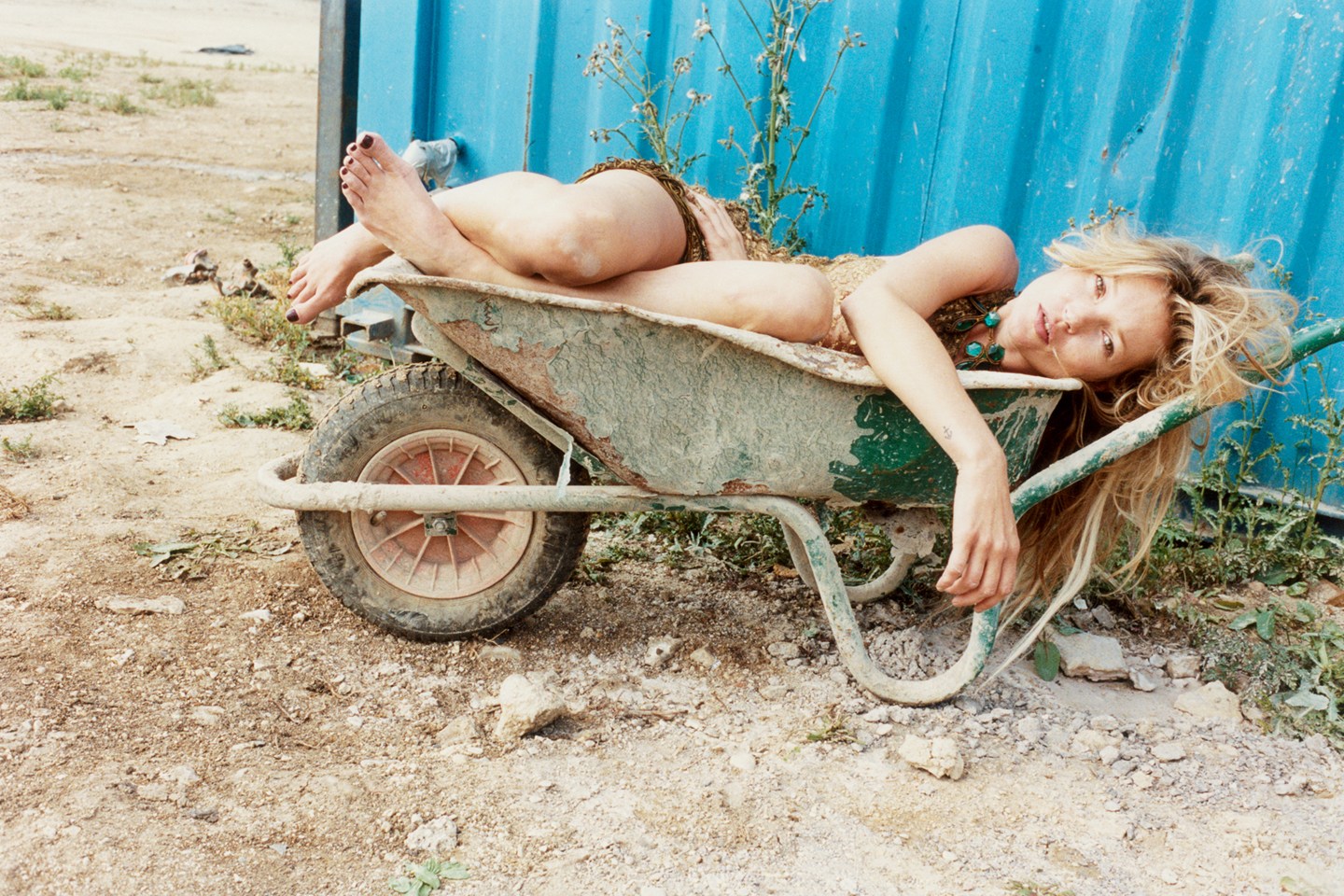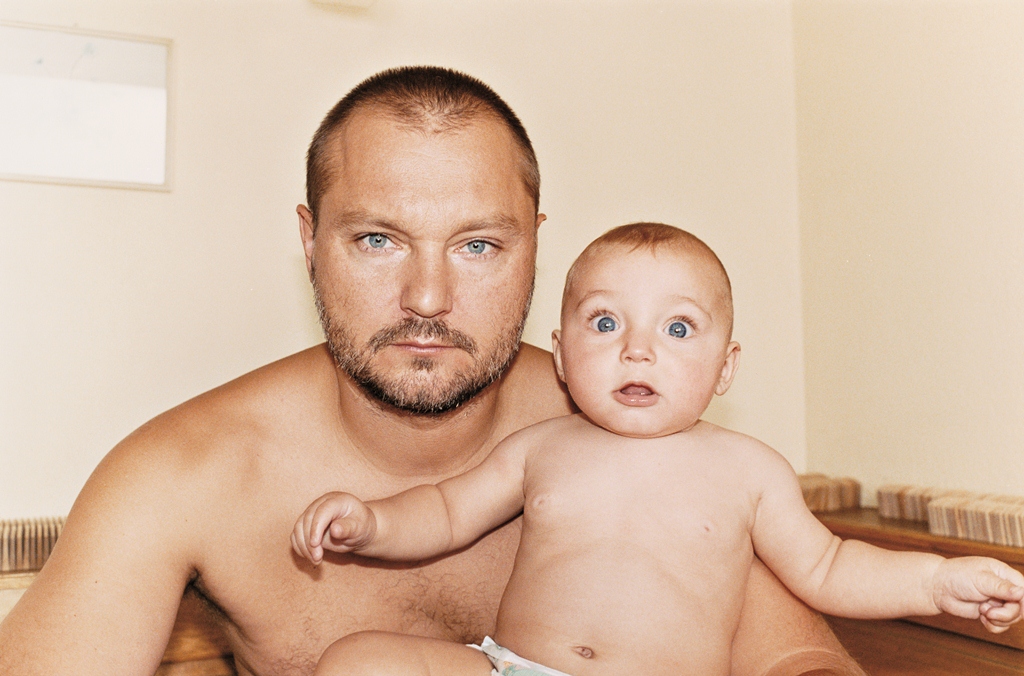Juergen Teller: Woo!, ICA | reviews, news & interviews
Juergen Teller: Woo!, ICA
Juergen Teller: Woo!, ICA
The German photographer's often confrontational images are ameliorated by warmth, wit and charm

Crossover isn’t the half of it. Not since Helmut Newton has a photographer operated so successfully in both the worlds of celebrity high fashion and the world of art.
Teller has collaborated with Helmut Lang and Yves St Laurent, among others. He devises advertising campaigns and is published in the high-end glossies, but his images are far from slick. With Woo!, which features work from the Nineties to the present day, Teller walks that tightrope between having a recognisable style yet also remaining unpredictable. He does not operate with one language, and even the most unassuming snapshot comes with an edge: is that young girl in the water holding a fishing rod or a rifle? There are several images of the very well known, from musicians – including Björk with her son (main image) and an early black and white photo of Kurt Cobain – to stars such as Victoria Beckham.
There is a curious authentic dignity to his imagery which is hauntingly credible
There are also some tender landscapes. The most recent work, Irene im Wald (2012), is a series of relatively small images of an unassuming piece of woodland near his natal home in Germany. The central character, we are told, is Teller’s mother. There is a narrative text underneath some of them in a tiny font; you really have to make an effort first to notice and then to read the explication. The terse sentences are biographical. His parents, perhaps improbably, worked in a family business making bridges for violins. The father was abusive, critical, drunken, and died before his son’s success.
 We learn too of Teller’s visit to the woods as a young boy (where he memorably and accidentally witnessed a shocking scene from an art film in process), his coming to London and having the money his mother had secretly sent him stolen, the second marriage of his mother to her brother-in-law, and the apparent calmness of familial relations now. The photographs have a sense of the unforced amateur that only the professional can provide: he doesn’t use digital, but rather old-fashioned analogue flash, even in daylight. There is a curious authentic dignity to his imagery which is hauntingly credible.
We learn too of Teller’s visit to the woods as a young boy (where he memorably and accidentally witnessed a shocking scene from an art film in process), his coming to London and having the money his mother had secretly sent him stolen, the second marriage of his mother to her brother-in-law, and the apparent calmness of familial relations now. The photographs have a sense of the unforced amateur that only the professional can provide: he doesn’t use digital, but rather old-fashioned analogue flash, even in daylight. There is a curious authentic dignity to his imagery which is hauntingly credible.
With Teller, the risible is peculiarly appealing and the potentially shocking oddly charming; high jinks and comedy ameliorate any possible sting. There is no distinction between the clothed and the unclothed. Vivienne Westwood reclines on a slightly shabby brocaded sofa, drapes herself in a take-off of Manet’s Olympia, and happily seats herself limbs akimbo, entirely naked except for a minimal necklace and facial makeup reminiscent of the 18th century. Her insouciant confidence is immensely appealing. Lily Cole, naked too, her porcelain skin lightly dusted by the sun, is slim, full-breasted and beguiling. The surface on which she is stretching her body seems to be a horrible rubbish heap.
 Teller appears as himself. In one image his penis rests coyly against his wife’s pregnant body; in another he is kneeling on a piano in a lush drawing room, presenting his naked bottom for our casual inspection while Charlotte Rampling, clothed, is seated at the piano as though about to play. He also photographs his children. We see him tenderly holding his young son, both widely blue-eyed (pictured above right), and his baby’s face haloed in bubbles emerging from the bath.
Teller appears as himself. In one image his penis rests coyly against his wife’s pregnant body; in another he is kneeling on a piano in a lush drawing room, presenting his naked bottom for our casual inspection while Charlotte Rampling, clothed, is seated at the piano as though about to play. He also photographs his children. We see him tenderly holding his young son, both widely blue-eyed (pictured above right), and his baby’s face haloed in bubbles emerging from the bath.
All we see of Victoria Beckham are her splayed out legs from the knees down, her feet shod in avant-garde shoes without heels; the monstrous swollen birth that is emerging is a huge Marc Jacobs shopping bag. Kate Moss, inescapably elegant, is crumpled in an old wheelbarrow set against a blue painted wall of corrugated iron; her feet are neatly manicured. (Pictured above centre, Kate Moss, No. 12)
The ICA reading room is wallpapered with decades of Teller’s photographs, stars given the same status as unknowns, recognisable faces next to everyman and everywoman, all slightly off kilter. You don’t need the captions (as so much of photography often does) to be captivated. However niche, it is a whole world.
Explore topics
Share this article
The future of Arts Journalism
You can stop theartsdesk.com closing!
We urgently need financing to survive. Our fundraising drive has thus far raised £49,000 but we need to reach £100,000 or we will be forced to close. Please contribute here: https://gofund.me/c3f6033d
And if you can forward this information to anyone who might assist, we’d be grateful.

Subscribe to theartsdesk.com
Thank you for continuing to read our work on theartsdesk.com. For unlimited access to every article in its entirety, including our archive of more than 15,000 pieces, we're asking for £5 per month or £40 per year. We feel it's a very good deal, and hope you do too.
To take a subscription now simply click here.
And if you're looking for that extra gift for a friend or family member, why not treat them to a theartsdesk.com gift subscription?
more Visual arts
 'We are bowled over!' Thank you for your messages of love and support
Much-appreciated words of commendation from readers and the cultural community
'We are bowled over!' Thank you for your messages of love and support
Much-appreciated words of commendation from readers and the cultural community
![SEX MONEY RACE RELIGION [2016] by Gilbert and George. Installation shot of Gilbert & George 21ST CENTURY PICTURES Hayward Gallery](https://theartsdesk.com/sites/default/files/styles/thumbnail/public/mastimages/Gilbert%20%26%20George_%2021ST%20CENTURY%20PICTURES.%20SEX%20MONEY%20RACE%20RELIGION%20%5B2016%5D.%20Photo_%20Mark%20Blower.%20Courtesy%20of%20the%20Gilbert%20%26%20George%20and%20the%20Hayward%20Gallery._0.jpg?itok=7tVsLyR-) Gilbert & George, 21st Century Pictures, Hayward Gallery review - brash, bright and not so beautiful
The couple's coloured photomontages shout louder than ever, causing sensory overload
Gilbert & George, 21st Century Pictures, Hayward Gallery review - brash, bright and not so beautiful
The couple's coloured photomontages shout louder than ever, causing sensory overload
 Lee Miller, Tate Britain review - an extraordinary career that remains an enigma
Fashion photographer, artist or war reporter; will the real Lee Miller please step forward?
Lee Miller, Tate Britain review - an extraordinary career that remains an enigma
Fashion photographer, artist or war reporter; will the real Lee Miller please step forward?
 Kerry James Marshall: The Histories, Royal Academy review - a triumphant celebration of blackness
Room after room of glorious paintings
Kerry James Marshall: The Histories, Royal Academy review - a triumphant celebration of blackness
Room after room of glorious paintings
 Folkestone Triennial 2025 - landscape, seascape, art lovers' escape
Locally rooted festival brings home many but not all global concerns
Folkestone Triennial 2025 - landscape, seascape, art lovers' escape
Locally rooted festival brings home many but not all global concerns
 Sir Brian Clarke (1953-2025) - a personal tribute
Remembering an artist with a gift for the transcendent
Sir Brian Clarke (1953-2025) - a personal tribute
Remembering an artist with a gift for the transcendent
 Emily Kam Kngwarray, Tate Modern review - glimpses of another world
Pictures that are an affirmation of belonging
Emily Kam Kngwarray, Tate Modern review - glimpses of another world
Pictures that are an affirmation of belonging
 Kiefer / Van Gogh, Royal Academy review - a pairing of opposites
Small scale intensity meets large scale melodrama
Kiefer / Van Gogh, Royal Academy review - a pairing of opposites
Small scale intensity meets large scale melodrama
 Jenny Saville: The Anatomy of Painting, National Portrait Gallery review - a protégé losing her way
A brilliant painter in search of a worthwhile subject
Jenny Saville: The Anatomy of Painting, National Portrait Gallery review - a protégé losing her way
A brilliant painter in search of a worthwhile subject
 Abstract Erotic, Courtauld Gallery review - sculpture that is sensuous, funny and subversive
Testing the boundaries of good taste, and winning
Abstract Erotic, Courtauld Gallery review - sculpture that is sensuous, funny and subversive
Testing the boundaries of good taste, and winning
 Edward Burra, Tate Britain review - watercolour made mainstream
Social satire with a nasty bite
Edward Burra, Tate Britain review - watercolour made mainstream
Social satire with a nasty bite
 Ithell Colquhoun, Tate Britain review - revelations of a weird and wonderful world
Emanations from the unconscious
Ithell Colquhoun, Tate Britain review - revelations of a weird and wonderful world
Emanations from the unconscious

Add comment